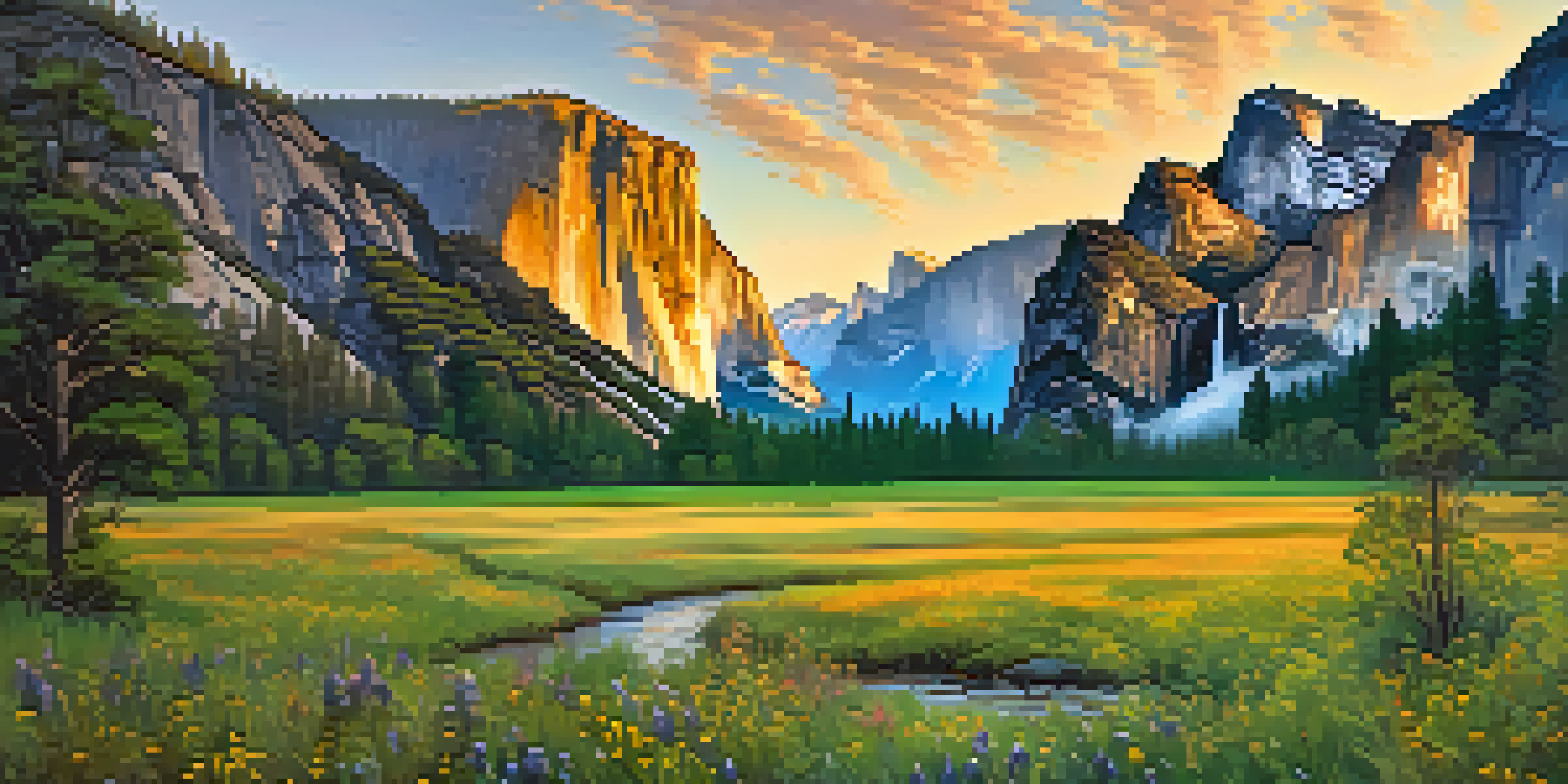California's National Parks: A Global Nature Destination

California's Diverse Landscapes: A Natural Wonderland
California is home to a stunning array of landscapes, from majestic mountains to serene coastlines. This diversity creates unique ecosystems that attract nature lovers from around the world. Each park offers a different experience, showcasing the state's natural beauty in various forms, whether it's the towering trees of Sequoia or the rugged cliffs of Point Reyes.
In every walk with nature one receives far more than he seeks.
In these parks, you can hike through lush forests, explore desert terrains, or relax by pristine lakes. This variety not only enhances the adventure but also provides a chance to witness the rich biodiversity. For instance, in Yosemite, you can encounter everything from black bears to vibrant wildflowers, making it a haven for wildlife enthusiasts.
The blend of these landscapes makes California's national parks a global destination. Visitors come from far and wide, drawn by the allure of breathtaking views and the chance to disconnect from the hustle of modern life. It's a place where nature's grandeur can inspire and rejuvenate anyone who steps foot within its boundaries.
Iconic National Parks: Gems of California
California boasts nine national parks, each with its own unique charm and attractions. Yosemite National Park, perhaps the most famous, is renowned for its stunning granite cliffs, such as El Capitan and Half Dome. These iconic formations draw climbers and photographers alike, eager to capture their beauty.

Then there's Sequoia and Kings Canyon National Parks, where visitors can stand in awe of the giant sequoias, some of the largest trees on Earth. Walking among these ancient giants is a humbling experience that connects you to nature's history. Similarly, Joshua Tree National Park offers a stark yet beautiful landscape, famous for its unique Joshua trees and surreal rock formations.
Diverse Landscapes Await Exploration
California's national parks offer a stunning variety of landscapes, from mountains to coastlines, attracting nature lovers and adventurers alike.
Each park tells a story through its landscape, inviting visitors to explore and discover. Whether you're camping under the stars in Death Valley or wandering through the wildflower-filled meadows of Channel Islands, these parks are not just destinations; they are experiences that resonate deeply with each traveler.
Adventure Awaits: Activities in the Parks
California's national parks are a playground for outdoor enthusiasts, offering a plethora of activities to suit every interest. Hiking is perhaps the most popular way to explore, with trails ranging from easy strolls to challenging backcountry routes. The Pacific Crest Trail, which runs through several parks, is a bucket-list hike for many adventurers.
The Earth has music for those who listen.
For those who prefer water activities, parks like Lake Tahoe and Channel Islands provide opportunities for kayaking, swimming, and snorkeling. Imagine paddling through crystal-clear waters surrounded by breathtaking scenery. The thrill of spotting sea life or enjoying a sunset from a kayak is an experience that lingers long after the adventure ends.
Rock climbing is another exhilarating option, especially in Yosemite, where climbers of all skill levels can find routes that challenge and inspire. Meanwhile, wildlife watching, photography, and ranger-led programs offer more laid-back ways to connect with nature. No matter your preference, there's an adventure waiting for you in California's national parks.
Cultural Significance: History and Heritage
Beyond their natural beauty, California's national parks hold significant cultural and historical value. Many parks are home to ancient Native American sites, offering a glimpse into the rich history of the land's first inhabitants. For instance, the Chumash people have lived in the Channel Islands for thousands of years, leaving behind artifacts that tell their story.
Visitors can learn about these cultures through interpretive programs and museum exhibits found within the parks. This connection to history adds depth to the experience, reminding us that these landscapes are not only beautiful but also steeped in tradition and heritage. Understanding this context enhances our appreciation for the parks.
Cultural Heritage and Conservation
These parks are rich in cultural significance, showcasing the history of Native American tribes and highlighting the importance of conservation efforts.
Moreover, the establishment of these parks reflects a broader movement towards conservation and environmental protection. The efforts to preserve these natural wonders for future generations underscore the importance of respecting and valuing our planet. It's a story of resilience and stewardship that resonates with visitors looking to connect with both nature and history.
Conservation Efforts: Protecting Nature's Beauty
Conservation is at the heart of California's national parks, ensuring that their beauty endures for generations to come. These parks are not just places to visit; they are sanctuaries for wildlife and ecosystems that need protection. Efforts by the National Park Service and local organizations work tirelessly to maintain these environments and educate the public about their importance.
One of the primary goals of conservation in these parks is to combat the effects of climate change, which threatens delicate ecosystems. Initiatives such as controlled burns and habitat restoration help preserve the natural balance. Additionally, park rangers play a crucial role in monitoring wildlife and maintaining trails, ensuring a safe and enjoyable experience for visitors.
Every visitor has a role to play in conservation too. Simple actions like staying on designated trails, packing out trash, and respecting wildlife can significantly impact preserving these beautiful landscapes. By practicing responsible tourism, we can enjoy the parks while helping to protect them for the future.
Planning Your Visit: Tips and Tricks
Planning a trip to California's national parks can be an exciting yet overwhelming experience. With so many parks to choose from, it's essential to consider what type of adventure you're looking for. Do you want to hike through towering trees, explore desert landscapes, or kayak in pristine waters? Each park offers unique experiences that cater to different interests.
Timing your visit is also crucial. Spring is often the best time for wildflower blooms, while fall showcases vibrant foliage. However, summer is peak season, so expect larger crowds. Booking accommodations early can make a significant difference, whether you're camping under the stars or staying in park lodges. Be sure to check for any seasonal closures or special events that might enhance your visit.
Adventure Activities for Everyone
With a plethora of activities like hiking, kayaking, and rock climbing, California's national parks cater to outdoor enthusiasts of all skill levels.
Lastly, come prepared with the right gear and knowledge. Familiarize yourself with park regulations and safety tips, especially if you're venturing into the backcountry. With a little planning, your visit to California's national parks can be a memorable and enriching experience.
The Lasting Impact of Nature: Memories and Reflection
The memories created in California's national parks often stay with visitors long after they leave. Whether it's the breathtaking view from a mountain peak, the tranquility of a secluded beach, or the thrill of spotting wildlife, these experiences shape our connection to nature. Many people find that spending time in these parks fosters a sense of peace and clarity that is hard to replicate elsewhere.
Reflecting on these moments encourages us to appreciate the beauty of our natural world. They remind us of our responsibility to protect these spaces, ensuring they remain untouched for future generations. Many visitors leave with a renewed sense of purpose, inspired to advocate for the environment and engage in conservation efforts back home.

Ultimately, California's national parks are more than just destinations; they are transformative spaces that invite us to explore, reflect, and connect with nature. As we share these experiences with others, we create a collective appreciation for the beauty and importance of preserving our planet's natural treasures.